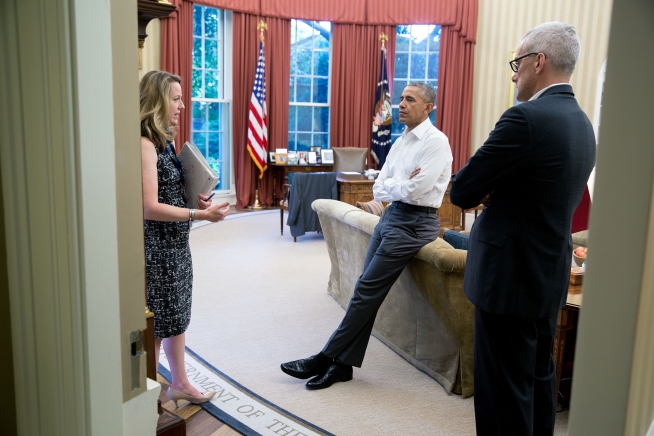
Will history give Trump a thumbs-up for his first 100 days? (AP Photo/Luis M. Alvarez)
By Robert Speel, Pennsylvania State University
The federal government is currently being funded by a continuing resolution that expires on April 28, 2017 – which also happens to be the 99th day of Donald Trump’s presidency. ![]()
If Congress fails to approve a new spending deal before then, Trump’s 100th day as president will begin with a federal government shutdown.
The last government shutdown took place under President Obama and lasted for more than two weeks in 2013. Hundreds of thousands of federal government employees were furloughed. The Smithsonian museums and National Park Service sites were closed, including the Statue of Liberty, Independence Hall in Philadelphia and the Washington monuments and memorials.
With current fights in Congress over spending on the military, the border wall and sanctuary cities, it’s certainly possible that no new continuing resolution will be passed in time.
That would make Trump’s 100th day in office an unusual anniversary, but the truth is not all recent presidents have much to brag about when it comes to the impact of their first months in office.
Creating the concept
The idea of using a president’s first 100 days in office as a way to evaluate him began in 1933 with Franklin D. Roosevelt – although FDR actually had in mind measuring the New Deal achievements of the first 100 days of a special congressional session that year. In a July 24 Fireside Chat, FDR referred to “the crowding events of the 100 days which had been devoted to the starting of the wheels of the New Deal.” Journalists, historians and political scientists continued the practice of looking for accomplishments in the early months of a presidency.
During those 100 days, FDR got many major bills through Congress to battle the economic crisis of the Great Depression. These bills created the Public Works Administration and the Civilian Conservation Corps to provide job opportunities, the Federal Deposit Insurance Corporation to insure bank deposits and the Tennessee Valley Authority to provide rural electricity. This flurry of activity became the standard by which future presidents would be judged – often coming up short.
In a 2001 study, political scientists John Frendreis, Raymond Tatalovich and Jon Schaff determined that the presidents who followed FDR have not come close to his success levels in seeing proposed bills pass into law so early in their administrations. The authors attributed that to changes in Congress that have slowed down the lawmaking process.
Let’s consider how the presidents have done.
Truman to Clinton
Following FDR’s death, Harry Truman’s first 100 days were focused on the closing battles of World War II, with Germany’s surrender occurring less than one month after Truman took office.
Dwight Eisenhower’s first 100 days were similarly dominated by foreign policy, including the death of Soviet Union leader Joseph Stalin and negotiations to end the Korean War.
John Kennedy entered office with an ambitious agenda, which included the creation of the Peace Corps, but his first 100 days are probably best remembered for the disastrous Bay of Pigs invasion of Cuba.
Lyndon Johnson’s first 100 days were most consumed by coping with the aftermath of Kennedy’s assassination, but LBJ also used the period and Kennedy’s legacy to begin the groundwork to pass major civil rights and war on poverty legislation.
While Richard Nixon also promoted an ambitious domestic agenda in the White House, his first 100 days contained no major visible achievements at the time. Nixon told reporters: “I don’t count either the days or the hours, really. I never thought in those terms. I plan for a long term.” Later, it was revealed that he had ordered a secret bombing of Cambodia during the period.
Gerald Ford’s first 100 days are best remembered for his swearing-in ceremony following Nixon’s resignation, when he announced that “our long national nightmare is over.” He then pardoned Nixon one month later for any crimes the former president had committed in office.
Jimmy Carter also had an inauspicious start. Possibly due to his inexperience in Washington, he asked Congress to pursue several different domestic policy goals, many of which never passed into law. Perhaps best remembered from Carter’s early months is his speech from the White House to declare that energy policy and efforts to end American dependence on oil were the “moral equivalent of war.”
Ronald Reagan’s administration drew the lesson from his immediate predecessor that it was best to focus on one or two domestic issues during the first 100 days. Reagan spent his first months as president promoting an agenda of tax and spending cuts, though those did not pass into law until August 1981, four months later. Reagan’s first 100 days as president were also notable for the assassination attempt made against him, which limited his political efforts for part of the time period.
George H.W. Bush’s first 100 days as president were largely a continuation of the policies of the Reagan presidency. They were noted at the time for being relatively uneventful, with a congressional battle over a secretary of defense nominee and the Exxon Valdez oil spill in Alaska dominating the political news.
The biggest political news story during Bill Clinton’s first 100 days was probably the failure of his stimulus package of domestic spending increases to get past a Republican filibuster in the Senate, though the eventual budget that resulted helped steer the United States toward budget surpluses later in the decade. Clinton’s first month also included his signing of the Family and Medical Leave Act into law, the start of a debate about service of gays in the military and the creation of a task force on national health care reform, chaired by Hillary Clinton.
The 21st century
George W. Bush took office in January 2001 after a disputed electoral outcome in Florida led to a 5-4 Supreme Court decision that essentially made him president. In a politically divided country, Bush’s strategy seemed to be to avoid controversy and build his political capital, with his major legislative proposals in the time period involving tax cuts and education reform.
Due to the economic crisis that began during Bush’s final months as president, Barack Obama’s first 100 days in office were dominated by the passage of the American Recovery and Reinvestment Act, a package of economic stimulus investments that by some measures was even larger than those passed in FDR’s 100 days in 1933. During a CBS “60 Minutes” interview in November 2008, Obama even said he was reading about FDR’s 100 days as an example.
Which brings us back to Donald Trump.
Trump’s main political success so far has been the confirmation of Neil Gorsuch to the Supreme Court. His promised repeal and replacement of the Affordable Care Act failed to get support in Congress. His attempted travel entry bans of citizens of certain Islamic countries into the U.S. and attempted suspension of refugee entry have so far led to massive protests and have been blocked by federal judges.
The Trump administration has also taken military action in Syria, Iraq, Yemen and Afghanistan, approved the construction of oil pipelines through North Dakota and sent out a request for contract bids to build a border wall with Mexico. It’s not clear yet which of these events will be well-remembered a year – or 10 – from now.
One thing is sure. If the Liberty Bell or the Lincoln Memorial is closed to tourists on Trump’s 100th day as president, it’s likely that government malfunction will be what is remembered about Trump’s first few months in office.
Robert Speel, Associate Professor of Political Science, Erie campus, Pennsylvania State University. This article was originally published on The Conversation. Read the original article.




